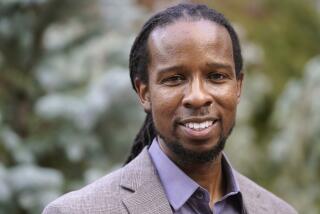BOOK REVIEW : One Manâs Quest to Kill Blood Diseases : LIFEâS BLOOD, <i> by Madeline Marget,</i> Simon & Shuster, $23; 272 pages
C ancer remains a terrifying word, despite the steady progress in treating the once-incurable disease. Former Massachusetts senator Paul Tsongas was the first recovered cancer patient to run for President. Predictably, soon after he announced his candidacy, the New York Times ran an editorial wondering whether the disease would recur.
Tsongasâ cancer has been in remission since 1985, so, statistically, he is cured. In another recent case that received much media attention, 19-year-old Anissa Ayala was apparently saved from life-threatening leukemia by a bone marrow transplant from a baby sister conceived--controversially--for that purpose.
Tsongasâ cancer, called non-Hodgkinâs lymphoma, and Ayalaâs leukemia are cancers of the blood. About 20,000 Americans are stricken with blood cancers each year. Besides lymphoma and leukemia, these diseases include such relatively unknown ailments as aplastic anemia, Gaucherâs and Wiskott-Aldrich syndromes, among others. Such diseases were almost invariably fatal 30 years ago, but thanks to hard-won improvements in treatment, they can be cured, if diagnosed early, in about half the cases.
Based on extensive interviews with patients and their families, âLifeâs Bloodâ records cases of blood disease and their treatment by an internationally known doctor.
The doctorâs specialty is bone-marrow replacement. The last-ditch treatment for such diseases, used only in terminal cases such as Tsongasâ and Ayalaâs, the replacement operation supplies much of the bookâs high drama. Doctors first destroy the diseased marrow, using massive doses of either toxic chemicals or radiation, or a combination thereof, then infuse the body, as if transfusing blood, with healthy marrow. In a successful operation, the new marrow finds its way into the bones and begins to produce healthy red blood cells.
The process is shatteringly painful. âThey kill you, then they bring you back to life,â says one patient.
The man who works this magic is 53-year-old Dr. Joel Rappeport, a New Haven, Conn., hematologist and Yale Medical School professor. Known for utterly devoting himself to his patients, as well as for kicking holes in doors and publicly calling colleagues âstupid,â the tender but irascible Rappeport toils for stupefyingly long hours, oblivious of his wife and two children, searching obsessively for better treatments. âI couldnât have been a dermatologist,â he tells author Madeline Marget. âI wouldnât have been good at (treating) a neurotic itch.â
Among Rappeportâs patients is plucky Daniel Folsom, who was born on a Florida farm with severe Gaucherâs syndrome. Shrunken, wheelchair-bound and wearing a body cast to protect his fragile bones, Daniel suffered horribly from his disease and the increasingly Draconian therapies the doctors applied.
His mother took the slowly dying--and uninsured--boy to hospitals in Gainesville, Fla., then Atlanta, then Boston and finally to the National Institutes of Health in Bethesda, Md. After a dispute over who would pay the million-dollar-plus bill, Daniel was transferred out of Rappeportâs care, against the doctorâs will, and eventually to Florida, to die in his motherâs arms a week before his ninth birthday. During his tragic odyssey, his parents lost their farm and savings, declared bankruptcy and divorced.
A happier outcome is that of Jane Morris, a 45-year-old graduate divinity student at Yale. Having survived Hodgkinâs disease at 18, Morris was found to have lymphoma 23 years later. âIâm an incarnational person,â she tells the author. âI want to live physically. Iâm not ready for this other-side business yet.â In an operation similar to Tsongasâ, Rappeport transplants Morrisâ marrow--purged of its cancerous cells, and she recovers.
One patient who appears for brief moments throughout the book is the authorâs sister, Roberta, who contracted leukemia in middle age and eventually died of it. Marget blames Robertaâs premature death not on Rappeport, whom both women came to admire deeply, but on her obtuse and impatient primary-care physician, who dismissed her early symptoms as unworthy of concern.
After the cancer is finally diagnosed, Marget donates her bone marrow to her sister. But the operation comes too late. âI didnât like doctors, I didnât like hospitals, and I knew all about high-tech medicine and its practitioners,â the author says of her forced introduction to Rappeportâs world. But she grudgingly allows herself to be won over, and finally becomes the physicianâs clear-eyed acolyte.
âLifeâs Bloodâ may not allay the readerâs fear of cancer, but the book shines a bright light on the obscure world of hematology, and it will help the reader appreciate the extraordinary effort needed to achieve even the smallest advance in treating the baffling diseases of the blood.
Next: Jonathan Kirsch reviews âThe Sign and the Sealâ by Graham Hancock (Crown) .






